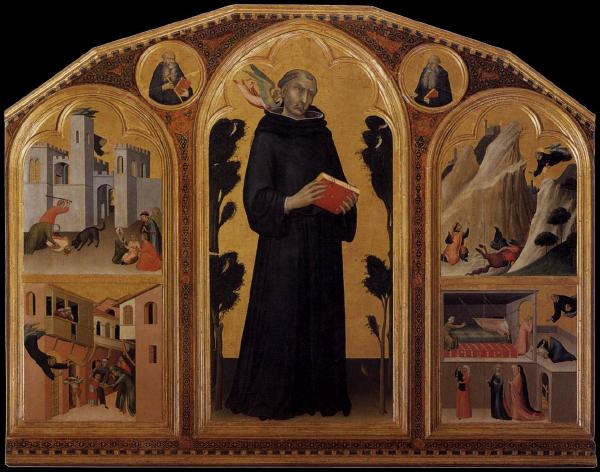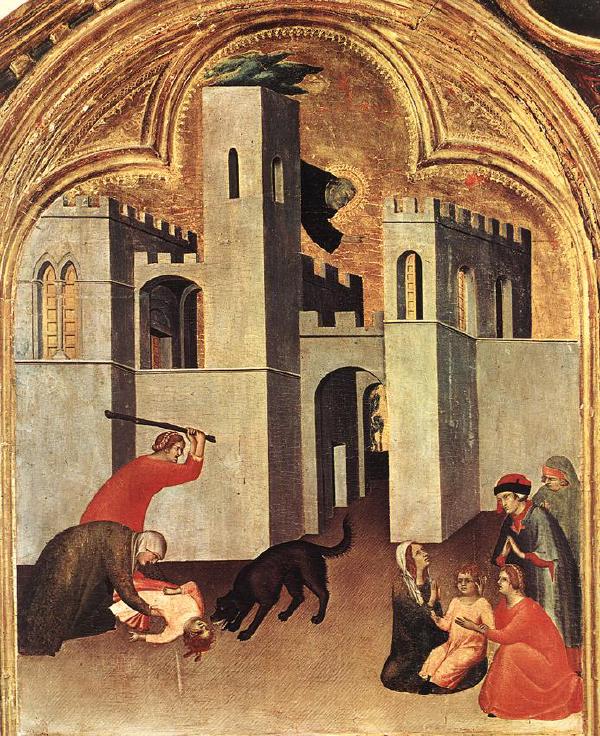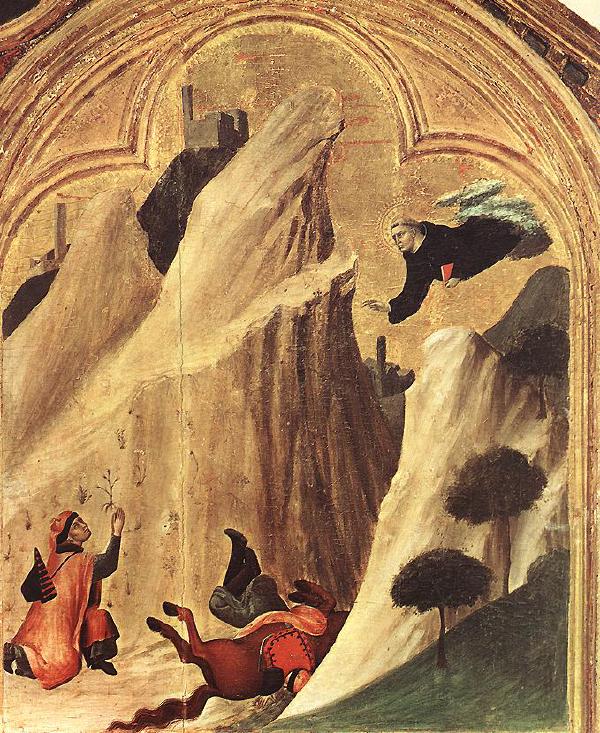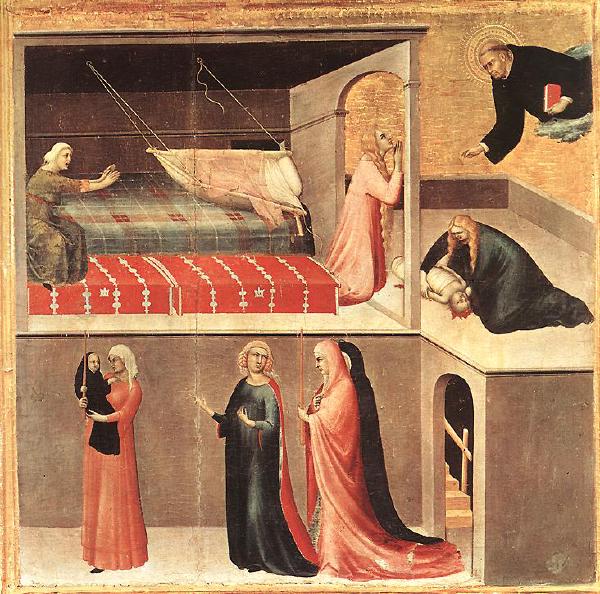My Favourite Painting
ZM
I have vivid dreams. In the mornings I sit bolt upright. The dream collects itself as the blood rushes away from my head. I dream about the people that populate my life - centre and periphery. They are characters that whirl around in weird places, across the narrative landscape of my sickening subconscious. They do mundane tasks, they float in the background like birds. They look different or they are out of context and it takes me a moment to recognise them from a distance. Sometimes we fuck - then, they are up close and we are face to face.
I dream about a walled city. It is pink. The kind of baby pink reserved for fresh babies and instagram adverts. The walls are high and you can see slices of the sky between shadowy rooftops. I dream that I am within the city. I am laying out hay for the horses that trot up and down its cobbled streets. I am dragging a basket full of peaches up cold stone steps. I am wrestling a snake under the wide, covered arches of a courtyard. The characters in my waking life are walking down the pink city’s narrow alleyways. They are going to work or going up to the mountains or going to buy pies. They are holding my hand as we walk the city’s perimeter together. They are silent. They are arranging their furniture to please the moon. They are breathing heavy and gripping my neck. Sometimes the city is under siege. Barbarian hoards gather at the walls and I sweat under the white sun. I ride out on a black horse to meet them. There is a sword in my hand. I fall from the top of the wall as my pink city burns. I fly over a heaving sea of soldiers, I swoop through the sky like a kite. I am tethered to the city. I can’t leave, there’s a limit holding me back.
I have a favourite painting. I don’t really understand why it is my favourite painting, or what the purpose of having a favourite painting even is. It’s not a fun fact I whip out in conversation. It’s not something that defines me. It’s more like a tender secret I hold in my head and my heart. I feel this animal pull towards it. I think of it often. I see it in other paintings I like. I return to it. It’s not even a whole painting. My favourite painting is a singular panel in Simone Martini’s Blessed Agostino Novello Triptych. Simone Martini was a painter from Siena in the early 14th Century - those sticky liminal years between Medieval times and the Renaissance. I cannot stop telling people: I love the paintings that came out of Siena during these crazy years, when everything was up for grabs. It’s all so Gothic and macabre, these ghastly unreal bodies floating in gilded golden space. Architecture is malleable, cities and space are liquid, stretching and tilting towards and away. Martini painted the Blessed Agostino Novello Triptych in the 1320s, Siena’s Golden Age, before the Black Death and the fall of the Republic. Siena was quiet when I arrived. There were cats gathered round the bins in an alleyway. I stomped down the city’s cobbled streets, bare legs and eyes wide to catch the infinite sun.

The altarpiece is shaped like a headboard or a tombstone. Three panels nestle inside. They look like fancy little windows. The middle panel is bigger than the outer two. It shows a full length portrait of a monk: Blessed Agostino Novello. He is wearing dark robes and he has that hairstyle that monks have - you know, that one? The folds of his hood are gathered around his neck and both his hands are holding the sides of a cherry red book. A miniature angel is hovering by his ear. It’s the size of a little bird. Its wings look like white dove wings too, flat grey and smooth with birdlike joints. The rest of the angel is wrapped in a pink fabric that ripples in an invisible wind. It has pointy little red feet that poke out the bottom of its curved body. The angel looks like it is whispering something into the monk’s ear. He’s tilting his head up to the side, to catch whatever the angel is saying. Actually, one of his eyebrows is slightly arched. There’s a little cluster of wrinkles in the middle of his forehead too. I’m so focussed on the content of this silent interaction for a reason. It’s probably because the angel and the monk are the only two features of this panel that feel like they have any clarity. The rest is flat. There’s the brown expanse of ground, it cuts off in a clean line with nothing on the horizon. The sky is cloudless. Gilded gold, interrupted by little etchings of a halo around the monk’s domed head, but they’re too fine to work out from this far away. And there are some spindly trees that frame the tall sides of the panel, their dark leaves billow out in bulbous splotches. They feel like a dark and blurry afterthought. I barely register them.
That middle panel is sandwiched between four smaller scenes.
The ground is flat brown again. The backdrop is a castle, this flat grey network of complex architecture. But backdrop is a word that implies a fading away or distance. The castle towers over the scene, looming and silent. It has the blank angular presence of a blade, so clean, so solid. The planes of its walls and surfaces are empty, they reflect nothing back at me and my eye slides across them. Beneath this monstrous space, two scenes unfold simultaneously. On the left: a child lies in agony, blood dribbling out of a head wound. A veiled woman bends over the child in despair. Her back is a curved roof, her arms tuck under the child’s body to lift it into her embrace. A woman behind her is wielding a stick, raised over her head and ready to strike. Facing them, a black dog baring its teeth and scrunching its brow in anger. Its teeth are tiny sharp and clear, rendered in halloween costume detail, inches away from the child’s grey face. On the right, there’s a parallel story/world: the child has been miraculously healed. It sits on the veiled woman’s lap, staring off into the middle distance with a wistful face. The two women give thanks. The veiled woman has her hands clasped together and her face tilted up to a robed figure who is bowing back at her. From behind one of the castle’s towers, the monk appears. He is swooping down from the golden sky, a dark cloud at his feet. His arm is outstretched, two fingers crooked in blessing. He looks down on the healed child with benevolent satisfaction.

A mountain valley, a grey rock face split in two. The valley is really just a suggestion of space between these towering lumps. They teeter up in soft peaks. Two travellers passing between. One is kneeling, hat hanging behind him and hands clasped, raised up. He is beseeching or giving thanks - maybe it’s both? I can’t tell. I guess it depends on what moment this traveller is suspended in. Next to him, his companion is barely visible: only his legs and the crown of his head. The rest is trapped beneath a fallen horse or obscured behind the edge of the closest mountain. The horse is brown and smooth and we can only see its back legs, its tail. Its legs are in the air, askew. Its tail is pooled in a neat squiggling line, sleek and unreal. From on high, descending down from the golden sky above the mountain - the monk. The same swooping curve of his body pops out of the same dark cloud. The same fingers are crooked in blessing.

Architecture melts as urban space turns itself inside out, splits open. A cross section of a building. Upstairs, an old woman screams. Her arms grasp the air in front of her, her face is contorted, eyes wide with horror. A cradle swings out of control, one corner of it has come loose and the string is recoiling, flying up into the air. Two women with long blonde hair in loose waves spill the scene out onto a balcony. They have large, unreal bodies. One is on her knees, her hair tumbling over bare shoulders as her hands clasp together beneath her upturned face. The second woman is more interesting. Her body becomes a pyramid beneath her. Her arms are wide and round. Her head is tiny in comparison. Even though she’s looking down, her face is scrunched up smaller and twisted in a visceral agony. She is mid-sob. Below, in the bracket of her smooth arms, a swaddled baby lies dead on the floor. There’s blood seeping out from its head and its body. The monk appears, body cut off by the side of the frame. The dark cloud carrying him is only visible in little wisps. Below, four women walk in procession through a blank corridor. The woman at the front is carrying a child dressed in black. The woman and the child look at each other in silent complicity, sharing something intense and unspoken. The child looks strange, other-worldly. Like an adult face has been plastered onto this little baby body. It makes me feel a bit woozy. One woman trails at the back of the procession. She is wearing a rosey pink robe that covers her from the top of her head and drags out behind. She looks like a figurine; so perfectly pleated and smooth. She is holding a stick. Their solemn procession makes no sense to me. I don’t know who they are, or actually when they are. I don’t understand how they exist in relation to the scene taking place above them, the baby and the cradle and the omnipresent monk.

Pink city walls. The buildings are nestled so close together. I imagine you could hold hands with someone standing on the balcony opposite you. I wouldn’t recommend it though, because it all looks precarious. The buildings are tall and straight and the windows are thin. Space is something that slips through these little voids, slender holes, punctures. It’s a dizzy thing. Not dizzying, it is itself dizzy. Angles are isolated, dislocated. Perspective is stacked up so each surface just kind of exists independently. No wonder the child fell from the balcony. They’re mid-air, in the act of falling. Hands outstretched towards the approaching ground, skirt rippling out in the headwind and feet flailing. A woman leans out of the balcony above, holding back the strings of her bonnet. She’s aghast. Luckily, the monk is here to fix it all. He flies down, body bent for action in the same swooshing crescent. In one hand he holds the loose plank of wood, the guilty one that gave way from the balcony and sent the kid flying. His other hand is raised in two fingered blessing. His domed head is crowned by a little golden halo. Further back in the alleyway, a crowd gathers, gawking at the dramatic scene in front of them. Adults react in horror and astonishment, but at the centre of the crowd is a child - wearing the same robe as the child that’s falling, the same hair too. Above them all, a slice of golden sky.
I honestly don’t know if it is the same kid. It confuses me. I’m not used to images that crunch up time and space. It’s not natural for me to just assume that the scene is folding in on itself. But I have a hunch that it is the same kid because this doubling up of time has happened before - in the scene above where the kid’s getting attacked by a dog. The protagonists appear again, in the same frame, a moment after the action. But it’s the kind of crammed scene that makes me feel woozy - like the baby with the adult face, something isn’t right. This scene knows too much. It’s my favourite painting.
Because, right. Do you believe in miracles? I think I do. I’m just not sure about what form they take. I think if miracles exist, they are small. They are discrete things. Not the spectacular displays from the lives of saints and martyrs. Like when he was beheaded, a well sprang up from where his blood hit the ground. The torture wheel broke when it touched her, the flames licked up the post and he didn’t burn, the arrows and the torture. All the suffering. I want something small that I don’t understand. The child is fine. Time doubles up and they’re able to witness the tragedy, but it’s only an intrusive thought. The way the image of falling haunts your mind’s eye as you walk downstairs. The angle of the dark windows and the balconies and the dizzy flat surfaces and the gulf space of the alleyway. It’s a small magic. It’s sleight of hand. It’s a pictorial lie. I’m not really that concerned with the slapstick presence of the flying monk. He’s not the bit I don’t understand. I believe it. The monk is more real to me than the kid that’s watching itself die. The monk makes more sense than the weird jagged balconies and the widened out fisheye perspective. Maybe he’s conjuring the magic, but he’s not a part of it.
Real life is strange. Or maybe just mine is - at the moment (and always). I wake, I sleep, I slip between these two states, stretching the plasticky membrane that separates them. I pass through with ease, I drag a trail of residue between them. I cannot tell them apart, sometimes. My dreams make perfect rational sense. They wax mystical with their disproportionate stresses. Coherent and physically jumbled, sensitive. The pink city I dream of is the same as the one in the painting.